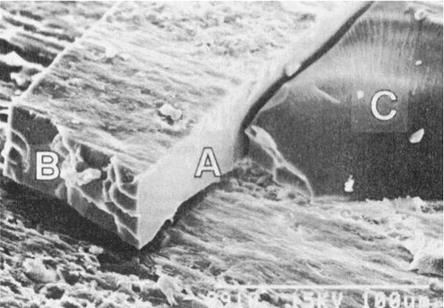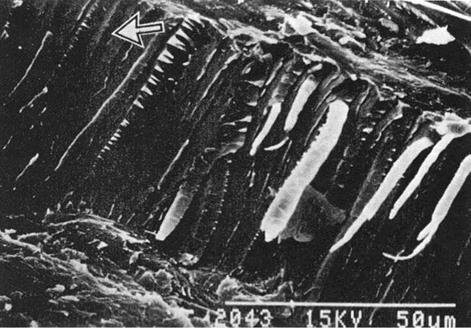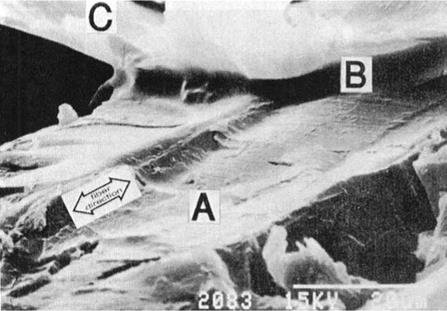The fracture toughness of wood in terms of crack initiation energy ranges from 50 to 1000 J/m2, whereas the crack initiation energies for typical thermosetting polymers are in the range 100 to 300 J/m2 [27]. It seems interesting that wood joints bonded with conventional thermosetting adhesive also have fracture toughness values of about 100 to 300 J/m2 (Table 1). Much higher values are possible if the adhesive is toughened by the addition of fillers or plasticizers.
|
Mode |
Adherend |
Adhesivea |
Fracture toughness Kc Gic (kPa m1/2) (J/m2) |
Ref. |
|
|
Cleavage |
Beech |
PVA |
— |
1206 |
11 |
|
PVA/phenol |
— |
390 |
|||
|
PF |
— |
170 |
|||
|
RF/filler |
— |
390 |
|||
|
EP/P |
— |
200 |
|||
|
EP/60Pb |
— |
1180 |
|||
|
EP |
— |
200-340 |
13 |
||
|
EP/20P |
— |
280-460 |
|||
|
EP/40P |
— |
460-790 |
|||
|
EP/60Pb |
— |
450-1070 |
|||
|
Douglas-fir |
UF/filler |
— |
250 |
6 |
|
|
EPI |
— |
900 |
|||
|
ISO |
— |
300 |
|||
|
PRF |
— |
800 |
|||
|
PF |
— |
200 |
|||
|
PF/PVA |
— |
700 |
|||
|
Aspen |
PRF |
255 |
— |
28 |
|
|
Unknown |
UF/filler |
— |
530 |
29 |
|
|
UF/PVA |
— |
640 |
|||
|
PF/PVA |
— |
640 |
|||
|
UF/MF/filler |
— |
700 |
|||
|
PRF |
— |
870 |
|||
|
Yellow poplar |
Casein |
380 |
— |
30 |
|
|
EP |
430 |
— |
|||
|
PRF |
470 |
— |
|||
|
PVA |
680 |
— |
|||
|
Spruce |
PVA |
310 |
— |
||
|
Douglas-fir |
PVA |
550 |
— |
||
|
Southern pine |
PVA |
560 |
— |
||
|
Walnut |
PVA |
600 |
— |
||
|
Ash |
PVA |
680 |
— |
||
|
Maple |
PVA |
790 |
— |
||
|
Western red-cedar |
PRF |
280 |
— |
31 |
|
|
Solid wood |
180 |
— |
|||
|
Southern pine |
PRF |
520 |
— |
||
|
Solid wood |
430 |
— |
|||
|
Hard maple |
PRF |
690 |
— |
||
|
Solid wood |
490 |
— |
|||
|
Douglas-fir |
Solid wood |
410 |
— |
32 |
|
|
Southern pine |
33 |
||||
|
Earlywood |
PRF |
520 |
— |
||
|
Latewood |
PRF |
400 |
— |
|
(continued ) |
|
Fracture toughness
“Adhesive abbreviations are as follows: EP, amine-cured epoxy; P, polysulfide rubber flexibilizers; EP/20P, EP/ 40P, and EP/60P, amine-cured epoxy with 20, 40, and 60 parts polysulfide flexibilizer; EPI, emulsion polymer isocyanate; ISO, isocyanate; MF, melamine-formaldehyde; PF, phenol-formaldehyde; PF/PVA, phenol-formaldehyde flexibilized with poly(vinyl acetate); PVA, poly(vinyl acetate); PRF, phenol/resorcinol-formaldehyde; RF, resorcinol-formaldehyde; UF, urea-formaldehyde; UF/filler, UF with wheat flour; UF/MF/filler, UF/MF copolymer with wheat flour. bThick layer. cFB, flakeboard; LVL, laminated veneer lumber. |
Plasticizers used to reduce the modulus of thermosetting adhesives to match more closely the wood moduli perpendicular to the grain have a marked effect on the fracture toughness. The addition of 20 parts of poly(vinyl acetate) to phenol-formaldehyde (PF/PVA) adhesive increased mode I fracture toughness by 340%, from 200 J/m2 to almost 700 J/m2 (Table 1) [6]. Less rigid thermosetting adhesives, such as emulsion polymer isocyanate (EPI), produced joints with toughness as high as 900 to 1000 J/m2 (Table 1) [6]. In this case the toughness varied with the amount of isocyanate cross-linking agent. Toughness first increased as the amount of isocyanate was increased from 0 to about 6 parts per 100 parts of emulsion polymer, but then decreased with further additions (not shown in Table 1). When Takatani and Sasaki [13] added polysulfide rubber flexibilizer (P) to epoxy resin (EP) adhesive, the fracture toughness of bonded joints increased from about 200 J/m2 to 300 J/m2 (Table 1). The toughest joints were those made with thick adhesive layers, in which case the crack initiation energies rose as high as 900 to 1200 J/m2 (Table 1). Many other studies showed that flexible or semirigid adhesives produce joints having higher short-term strength and fracture toughness compared to rigid adhesives [13,31,39,40]. Takatani and others [11] observed that flexible adhesive improves the fracture toughness of joints made with rigid adherends such as spruce, beech, and oak; however, rigid adhesive improves the toughness of joints made with flexible adherends such as balsa.
Very high fracture toughness values for wood-adhesive joints can be attributed to a combination of adhesive plastic deformation and reduction of microcracking of the wood around the crack tip. A flexible adhesive layer, especially a thick layer, distributes the
|
|
|
|
|
|
|
|
|
|
|
|
|

![]()
crack tip
Figure 4 (a) Fracture process zone (area of stress concentration) surrounding the area or volume
of the bondline immediately ahead of the crack tip when the joint is subjected to cleavage, shear, or shrinkage forces; (b) small process zone and high stress concentration with rigid adherend and adhesive; (c) large process zone and low stress concentration with flexible adhesive and adherend.
concentrated stress over a larger area (volume) and lowers the level of the peak stress (Fig. 4). This apparently inhibits microcracking in the adjacent wood. Reduction of microcracking is indicated by the lower percentages of wood failure and lower counts of acoustic emission [41] per unit of new fracture surface in joints made with nonrigid adhesives compared to rigid thermosetting adhesives.
The fracture surface of a conventional urea-formaldehyde adhesive (Fig. 5) shows distinctive smooth brittle fracture surfaces formed when the adhesive layers cracked as a result of shrinkage stress that developed during cure [42]. A moderately toughened urea — formaldehyde bonded joint (Fig. 6) shows three distinct types of fracture surface arising under differing conditions: (A) cure shrinkage, (B) vacuum-pressure soak-dry (VPSD) treatment, and external loading to fracture (C). The rough surfaces are contrasted to the smooth cure-shrinkage crack surfaces. The crack caused by cyclic VPSD treatment (B) shows signs of plastic deformation. However, the plastic deformation does not have any directional properties. It appears to have occurred when the adhesive was in a
|
|
|
|
Figure 7 Fracture surface of a phenol-formaldehyde adhesive showing striations (arrow) indicative of plastic deformation, yielding, and toughness. |
weakened state, such as might occur from the absorption of water. Crack surface (C) occurred during testing when the material was dry and strong. Initially, it propagated at a high rate from the adhesive’s interface with the lower adherend toward the upper interface. As the crack slowed, the adhesive deformed plastically, leaving striations in the upper corner. The fracture surface (C) suggests strength and toughness. In contrast, a phenol-formaldehyde adhesive layer (Fig. 7) shows extreme plastic deformation and directionality. Both these traits suggest a tough, strong adhesive layer. In contrast to the blocky fracture surface that resulted from an adhesive layer that was precracked by cure shrinkage (Fig. 8), the phenol-formaldehyde adhesive remained uncracked until externally loaded to failure (Fig. 9). In addition to the plastic deformation seen at high magnification (Fig. 7), there are no preexisting cracks in the adhesive layer. During testing to failure, when the primary crack jumps across the adhesive layer from one interphase to the opposite, the cracked adhesive surface is most often sloped (arrow).
A rigid brittle thermosetting adhesive such as the unmodified urea-formaldehyde shown in Figs. 5 and 8 does not have the ability to arrest a growing crack, as evidenced by extensive brittle fracturing even before testing. A modified, toughened thermosetting adhesive does have this ability. Figure 10 shows an arrested crack in a fillet of amine- modified urea-formaldehyde adhesive in Southern pine particleboard subjected to 10 VPSD cycles. The rounded crack tip shows plastic deformation and blunting. A new sharp notch can be seen forming at the root of the blunt crack tip. The ability to blunt cracks in the adhesive layer or in the fillet of adhesive between particles or flakes tends to force fracture in the wood, as illustrated in Fig. 11 and discussed by River and others [42].
|
|
|
|
|
|
 11 июля, 2015
11 июля, 2015  Malyar
Malyar 






 Опубликовано в рубрике
Опубликовано в рубрике 